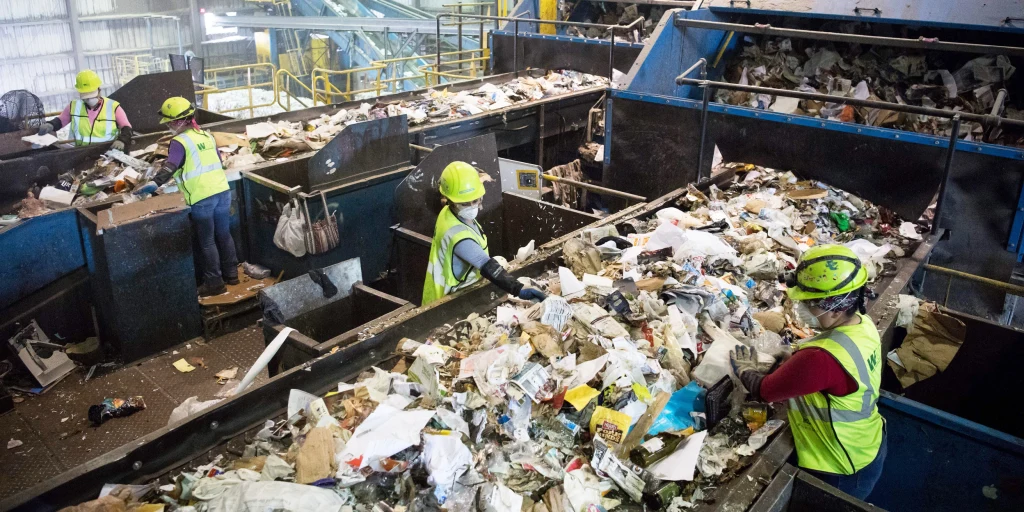Technological Trends Redefining the Waste Management Practices

Strong 8k brings an ultra-HD IPTV experience to your living room and your pocket.
Introduction:
Waste management has long been one of the most pressing issues faced by modern societies. As urbanization continues to rise and global consumption increases, the challenges of dealing with waste have become more complex. Traditional waste management methods, such as landfilling and incineration, have often come under scrutiny due to their environmental impacts. However, the advent of new technologies has begun to transform the waste management sector, offering cleaner, more efficient, and more sustainable solutions.
Get FREE Sample of the Waste Management Market Report: https://www.nextmsc.com/waste-management-market/request-sample
Among the most promising advancements is the shift toward waste-to-energy (WTE) technologies, which are revolutionizing how we deal with waste. These technologies are changing the landscape of waste management by transforming waste materials into valuable energy, thereby reducing the need for landfills and decreasing environmental pollution. This article explores the technological trends that are redefining waste management practices, focusing on the role of waste-to-energy solutions in the shift from landfills to clean power.
The State of Waste Management Today
Globally, the amount of waste produced continues to rise. According to the World Bank, the world generates more than 2 billion tons of waste annually, and this number is expected to increase by 70% by 2050. Waste management systems around the world have traditionally relied on landfills and incineration to dispose of waste. While these methods have been effective to a degree, they come with significant drawbacks. Landfills, for instance, contribute to greenhouse gas emissions, leachate contamination, and take up valuable land space. Incineration, on the other hand, can produce harmful air pollutants, including dioxins and particulate matter.
To address these challenges, governments, industries, and environmental organizations are increasingly focusing on developing innovative waste management technologies that can reduce the environmental footprint of waste disposal. As the world moves toward a more sustainable future, waste management is being integrated with renewable energy production, creating a circular economy where waste is seen as a resource rather than a burden.
Waste-to-Energy Technologies: The Shift from Landfills to Clean Power
Waste-to-energy (WTE) technologies represent one of the most promising advancements in the field of waste management. These technologies involve converting waste materials into usable energy, typically electricity, heat, or biofuels. The process of turning waste into energy not only helps reduce the volume of waste sent to landfills but also generates clean, renewable energy that can be used to power homes, businesses, and industries.
The shift from traditional waste disposal methods like landfilling to waste-to-energy technologies is driven by several factors, including the growing need for sustainable energy sources, the desire to reduce environmental pollution, and the need for more efficient waste management practices.
Types of Waste-to-Energy Technologies
There are several types of waste-to-energy technologies currently in use, each of which has its own benefits and applications. These include:
1. Incineration with Energy Recovery: This is one of the most common forms of waste-to-energy technology. It involves the combustion of waste materials at high temperatures, which generates heat that is used to produce steam. The steam drives turbines to generate electricity. While this process significantly reduces the volume of waste, it can produce emissions if not properly controlled.
2. Gasification: Gasification is a process that involves heating organic waste in a low-oxygen environment to produce a synthetic gas, or syngas. The syngas can be burned to generate electricity or converted into biofuels. Gasification is often considered a cleaner and more efficient alternative to incineration because it produces fewer pollutants.
3. Anaerobic Digestion: This technology involves breaking down organic waste, such as food scraps and agricultural waste, in the absence of oxygen to produce biogas. The biogas, which is primarily methane, can be used as a source of renewable energy. Anaerobic digestion is commonly used for waste from food processing, agriculture, and municipal solid waste.
4. Pyrolysis: Pyrolysis is a thermal decomposition process that heats waste materials in the absence of oxygen to produce oil, gas, and solid residues. The oil and gas produced in the pyrolysis process can be used as a fuel, while the solid residues can be further processed or used in various industrial applications.
The Environmental Benefits of Waste-to-Energy Technologies
Waste-to-energy technologies offer several environmental benefits over traditional waste management methods. First and foremost, they help reduce the need for landfills, which are a major source of greenhouse gas emissions. When organic waste decomposes in a landfill, it produces methane, a potent greenhouse gas that contributes to climate change. By diverting waste from landfills and converting it into energy, WTE technologies can help reduce methane emissions and minimize the environmental impact of waste disposal.
Additionally, waste-to-energy technologies provide a way to generate renewable energy from waste materials. By using waste as a feedstock for energy production, WTE facilities can contribute to the transition away from fossil fuels and towards cleaner, more sustainable energy sources. This is particularly important as the world seeks to reduce its reliance on nonrenewable resources and mitigate the effects of climate change.
Moreover, many waste-to-energy technologies, such as anaerobic digestion and gasification, produce lower emissions compared to traditional incineration, making them a more environmentally friendly option. These technologies also allow for the recovery of valuable resources from waste, such as metals and plastics, which can be recycled or reused.
Waste-to-Energy as Part of the Circular Economy
Waste-to-energy technologies play a key role in the development of a circular economy, where waste is considered a resource rather than a problem. In a circular economy, the goal is to keep materials in use for as long as possible, reduce waste, and minimize the need for new raw materials.
Waste-to-energy systems are an essential component of the circular economy because they help close the loop by converting waste materials into energy that can be used to power other processes. For example, waste heat produced by waste-to-energy plants can be used in district heating systems, providing heat to buildings and reducing the need for fossil fuels.
Additionally, many WTE technologies, such as anaerobic digestion and pyrolysis, allow for the recovery of valuable by-products, such as compost, biofuels, and biochar. These by-products can be used in agriculture, construction, and other industries, further promoting sustainability and reducing waste.
Challenges and Considerations in Waste-to-Energy Technologies
Despite the many benefits of waste-to-energy technologies, there are still challenges that need to be addressed. One of the main concerns is the cost of implementing these technologies. While WTE facilities can generate revenue from the energy they produce, the initial investment required for building and maintaining these facilities can be significant. Additionally, the operational costs of waste-to-energy plants can be high, particularly when dealing with complex waste streams that require specialized processing technologies.
Another challenge is the potential environmental impact of some waste-to-energy technologies, such as incineration. Although modern incinerators are equipped with advanced pollution control technologies, the burning of waste can still produce air pollutants, including dioxins, furans, and particulate matter. These pollutants can pose health risks to nearby communities if not properly controlled. Therefore, it is essential that WTE facilities are designed and operated with strict environmental regulations in place.
Furthermore, the efficiency of waste-to-energy technologies can vary depending on the type of waste being processed. For example, some materials, such as plastics and metals, can be difficult to convert into energy and may need to be separated before processing. As a result, WTE technologies may not be suitable for all types of waste and must be carefully integrated into a broader waste management strategy.
The Future of Waste-to-Energy Technologies
As the world continues to face the challenges of waste management and climate change, the role of waste-to-energy technologies will become increasingly important. Advances in technology are likely to improve the efficiency and environmental performance of WTE systems, making them a more attractive option for both waste management and renewable energy production.
For example, innovations in waste sorting and pre-processing techniques could help increase the quality and consistency of waste feedstocks, improving the efficiency of WTE plants. Similarly, the development of new materials and technologies for waste-to-energy conversion could make the process more cost-effective and reduce emissions.
Furthermore, as more countries adopt circular economy principles, the integration of waste-to-energy technologies with other sustainable practices, such as recycling and composting, will become more widespread. This holistic approach to waste management will help create a more sustainable future, where waste is minimized, resources are recovered, and energy is generated from renewable sources.
Conclusion
Waste-to-energy technologies represent a promising solution to the growing challenges of waste management and energy production. By converting waste materials into clean, renewable energy, WTE technologies can help reduce the environmental impact of waste, reduce reliance on landfills, and contribute to the transition towards a more sustainable energy future. While there are challenges to be addressed, including cost and environmental concerns, the continued development and implementation of waste-to-energy systems will play a critical role in creating a circular economy and addressing the pressing issues of waste and climate change. With ongoing innovation and investment, waste-to-energy technologies have the potential to reshape the future of waste management, turning waste into a valuable resource rather than a burden.
Read the complete blog: https://www.nextmsc.com/blogs/waste-management-market-trends
Note: IndiBlogHub features both user-submitted and editorial content. We do not verify third-party contributions. Read our Disclaimer and Privacy Policyfor details.


